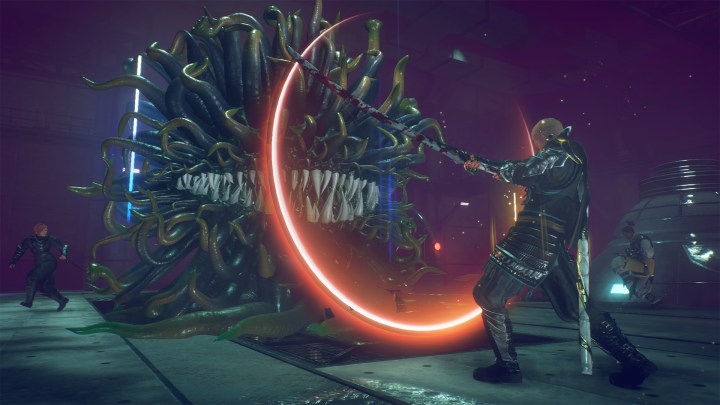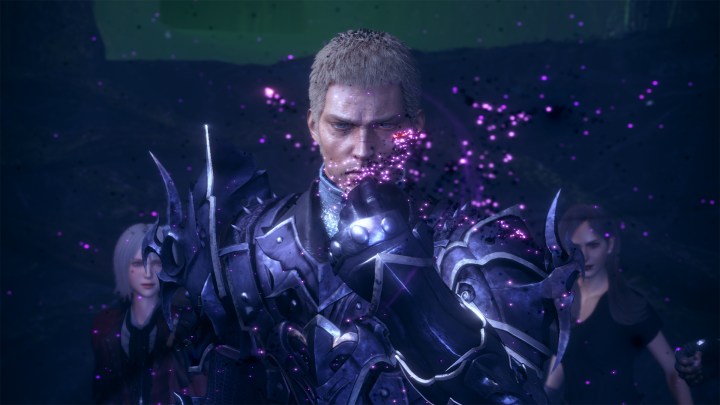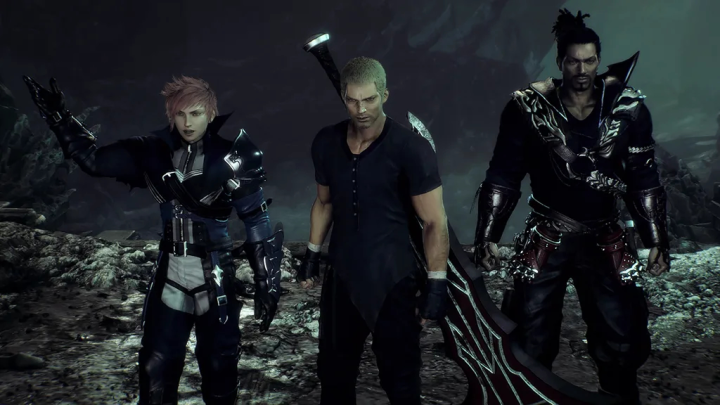Are you ready to kill Chaos? We all know that Jack is based on how much he talks about it, but you might be in for a bit more than you bargained for. Stranger of Paradise: Final Fantasy Origin is a very unique game for the series in almost every way. It calls back heavily to the original Final Fantasy and acts as somewhat of a retelling of that original game, but not quite. While we won’t spoil any of the story differences here, the gameplay differences are what really matter. This isn’t your typical turn-based JRPG like the original and isn’t even all that similar to the more action-focused titles Square-Enix has released as of late. This game is a new beast for fans of this historic series.
Developed by Team Ninja, which has just come off two very popular Souls-inspired Nioh games, it’s taken the reigns on the latest Final Fantasy spinoff. The result is a game that blends elements from both series into something new, meaning fans of either series will have a few hurdles they will need to overcome to fully grasp the new systems. JRPG fans in particular will have a serious hurdle wrapping their heads around a few of these new systems. If you’re struggling to overcome Chaos and his legion of foes, here’s a full beginner’s guide for Stranger of Paradise: Final Fantasy Origin to help you overcome the odds.
See more
- The best Final Fantasy games, ranked from best to worst
- The best Final Fantasy characters of all time
- The 10 best JRPGs of all time developed by Japanese studios
Pick your difficulty

Your first choice when booting up Stranger of Paradise: Final Fantasy Origin is what difficulty level you want to play on. There are five options, though the final one, Chaos Difficulty, will remain locked until you beat the game once on any of the other difficulty levels first. The ones you can pick from are Story, Casual, Action, and Hard.
Story difficulty is meant for players who are not really familiar with more action-focused games like this, perhaps only really enjoying the more strategic and less time-pressured mechanics of turn-based JRPGs, and who still want to experience the story of this game. This is the easiest this game can get and allows just about anyone to make it through without much pushback or challenge.
Casual difficulty is actually even easier than Story despite being listed below it in the options. The combat will be just as easy as it is in Story, but with a few extra bonuses tilting the scales further in the player’s favor. These include:
- The Break gauge (more on that below) consumption rate is lowered.
- Removes enemy unblockable attacks.
- Your maximum MP won’t decrease if you die.
- Teammates will automatically revive themselves if they die.
Action difficulty is your “normal” mode as it were. This is what the game is tuned to be played for the average player and where you should get challenged to use all the systems of Stranger of Paradise: Final Fantasy Origin but not hit many difficulty walls or spikes.
Hard is where things ramp up. Unless you’re familiar with action games, maybe don’t start with this difficulty level. The game expects a good level of execution and reactions from you in order to get through, especially against bosses. Grinding will also be necessary to keep up with the challenge curve.
Chaos, again not available until you beat the game once, is the ultimate challenge. Save this for when you’re fully geared and leveled up and want to put your best builds to the test.
While you need to pick one difficulty to start with, the good news is you’re not stuck with that choice for the entire game. Any time you’re at the world map, you have the option to go into the settings and raise or lower the difficulty with no repercussions. Don’t be afraid to raise and lower it as you see fit.
Combat basics and Break Gauge

Combat in Stranger of Paradise: Final Fantasy Origin is the most different of any Final Fantasy game so far, and even a good deal different from the Nioh games as well. It isn’t quite as Souls-like as Team Ninja’s previous games, but still very fast and frenetic. At the basic level, you will be doing melee, magic, and Instant Ability attacks to deal damage. Melee is mostly self-explanatory, but you should pay attention to and learn your basic combos since they can end with very devastating final attacks in the combo string. Also, try and position yourself to hit enemies from behind to get a critical hit bonus to your damage. Blocking is also important here, even more than your dodge. Unlike Nioh or many other Souls games, your dodge doesn’t give you any invincibility frames. That means that if you get hit while dodging, you’re taking that damage. Unless you dodge early and completely avoid an attack, it’s not worth it. Instead, just hold the Block button to reduce incoming damage and be ready to dish out a counterattack. If you time your block right as an attack is landing, you can also parry them and counter with a combo ability.
Magic should be incorporated into every build, even if you want to be as pure of a DPS or tank build as possible. Spells run the gamut from elemental attack types, such as fire, to support like cure and revival spells. But what is easily overlooked is that you can, and should, charge your spells whenever possible. By holding your Cast button rather than tapping it, each spell can gain up to three levels of charge. The more a spell is charged, the more effective it will be, typically in terms of damage and AoE.
The last major combat option is another defensive move called the Soul Shield. Whenever you see an attack that isn’t highlighted in red (unblockable), you can use your Soul Shield by pressing B or Circle. This will drain your Break Gauge and MP bar, so you can’t spam it and instead need to treat it like a parry. If you pull it off, you will take no damage and increase your max MP while restoring it at the same time. But if an enemy uses an ability written on a purple background, blocking it with your Soul Shield will not only give you the previously mentioned bonuses, but it will let you essentially steal and use that ability against the enemy you stole it from or any other foe. Any ability you steal is held until you use it or replace it, so feel free to retarget or hang on to a useful ability until you need it.
Last up, perhaps the most important new system in Stranger of Paradise: Final Fantasy Origin that you need to fully internalize and understand is the Break Gauge. This is vital because it is something you need to monitor for your own character, as well as all enemies. Starting with enemies, breaking their Break Gauge by dealing continuous damage with attacks, magic, and abilities will drain their Break Gauge until it ultimately … well, breaks. At this point, they become susceptible to a Soul Burst that, like Soul Shield, will restore your MP to full, but also instantly kill that enemy in a flashy finisher. It is somewhat like the posture system from Sekiro, where you can either focus on just working down an enemy’s HP normally or go for their Break Gauge and get an instant kill.
On the other hand, whenever you block or hold out your Soul Shield, your own Break Gauge will deplete. If yours runs dry, your character will drop to their knees for a few seconds, with no way to avoid any attacks. Thankfully you won’t get insta-killed unless you’re already low on health, but you should aim to never let this happen regardless, especially against bosses or stronger enemies. However, your Break Gauge is actually tied to your Job, not your character, so if your gauge is running low, you can switch to your other job and have a fresh one ready to go at the touch of a button while you let the other refill itself in the background.
Learn the Affinity system

The Affinity system is another massively important concept to learn that Stranger of Paradise: Final Fantasy Origin does a poor job of properly teaching. Affinity is something you can improve for each Job you have, and the higher the Affinity for that Job, the more XP that job will earn. In addition, increasing a Job’s Affinity will also unlock new passive buffs for your character when above 50%, some of which persist even when you’re not actively using that particular Job. While not as interesting as getting new moves, combos, or abilities, passive bonuses are always great to have for smoothing out the difficulty.
You can raise your Affinity in a few ways. The first is by equipping certain gear. When you look at a piece of gear, you can see that it will have a Job Affinity percentage, and if you stack enough gear that contributes to that Job’s Affinity, you will start unlocking those buffs. Since you’ll be sucking up hundreds of pieces of loot in Stranger of Paradise: Final Fantasy Origin, you can thankfully sort your gear by Job Affinity in the menu to make it easier to stack gear that fits the Job you want to level up.
The other way to raise Affinity is to unlock special abilities in your Job’s skill tree. These nodes will simply increase that Job’s base Affinity, making it easier to reach the threshold to get those passive buffs with gear. Try and unlock those skills as early as you can to make leveling up the Job easier going forward.
Focus on Jobs

Speaking of Jobs, this classic Final Fantasy system is back in a brand new way in Stranger of Paradise: Final Fantasy Origin. There are an astounding 28 Jobs in the game, each effectively being their own class, that you can level up and swap between. You don’t start with all of them, and can only have two Jobs equipped at a time for any given mission, but you will unlock more Jobs as you level up the ones you start with to get stronger ones.
Each Job has a skill tree where you can spend the points you earn by leveling that Job up to get new combos, buffs, and abilities, some of which can’t be unlocked without first completing the skill trees of other Jobs, so you will want to try and level up most, if not all, of your Jobs rather than focus on just a few for the most benefit.
Aside from earning XP by defeating enemies while using a specific Job, you can also spend a currency called Anima Shards to level up Jobs. The benefit of this is that this resource can be used to level up Jobs you aren’t using by dumping them into whatever Job you want to power up in the menu. These shards aren’t super common, though. The only way to get them is to complete main or side missions that offer them as a reward. Thankfully, you can repeat missions as many times as you want, and you will always get the same number of Anima Shards as a reward no matter how many times you’ve done that mission. Even difficulty won’t impact your rewards, so if you just want to grind out a ton as fast as you can, drop the difficulty down and blast through a mission over and over to farm up some shards.
Manage your loot and upgrade your gear
If you’ve played either Nioh game, you have an idea of just how much loot to expect to pick up in Stranger of Paradise: Final Fantasy Origin. If not, you’re probably going to be overwhelmed by just how much armor and weapons you will collect on any given mission. With so much loot, the vast majority will not be worth your time. Rather than stop every time you pick up a new glowing item to see if it is marginally better than what you’re currently using, wait until a mission ends to sort out what you’ve got and decide what’s worth keeping, what you want to dismantle, and what should be upgraded.
Aside from clearing out space in your limited inventory, dismantling gear will give you the materials you need to upgrade the gear that’s actually worth using, making even the most basic gear you’d never use still worth grabbing to make your good stuff better. All of this is done in the Smithy, which you can access on the main menu by tabbing over to the Cornelia tab and choosing the smithy option. Here, your two choices are to Upgrade Special Effects and Dismantle, which we’ve already gone over.
Upgrading Special Effects prompts you to pick what piece of equipment you have that you want to upgrade. From the list, you can see what upgrades you can get on the right-hand side of the screen, below the image of the gear. Once you pick what you want to improve, you can see what materials and what quantity are required to do it. If you have enough, you can go for it.
Do all your side missions
Outside of the main missions, side missions will pop up frequently that have you revisit previous locations with new objectives. This might sound like boring, filler content, but they are essential on harder difficulties for leveling up enough, getting enough gear, and grabbing some extra rewards. You can pick a side mission on the world map just like a main mission. In fact, you need to highlight a main mission indicator that you’ve already beaten, and then tab over to the Side Missions section. There are four main varieties: Beat a boss, defeat a number of enemies, collect an item, and destroy a specific object.
If you’re going to try and tackle the extra post-game level challenges in Stranger of Paradise: Final Fantasy Origin, you will be running plenty of side missions, so you might as well start early.
Party up

Finally, if things just aren’t going your way, replace those less-than-helpful A.I. companions with real ones. Stranger of Paradise: Final Fantasy Origin allows for three players to all team up on any mission in the game and is available right after you complete the prologue and begin the game. Every teammate brings in their own specific character, meaning that if you have a friend that’s a way higher level, they can carry you through a tough mission or boss, or you can play the entire game with friends from the jump and progress together. Either way, Stranger of Paradise: Final Fantasy Origin doesn’t scale its difficulty based on the number of players, so having competent friends along will always make it easier and more fun.



